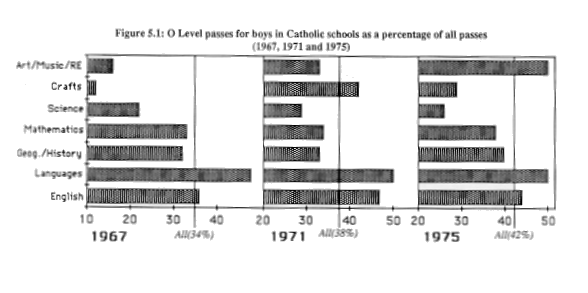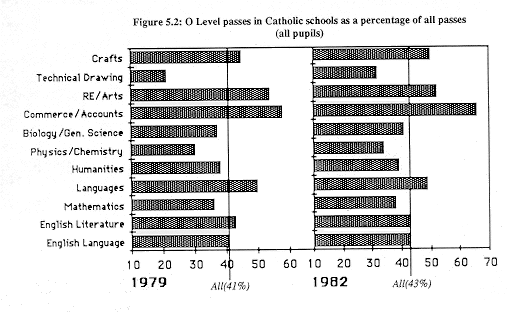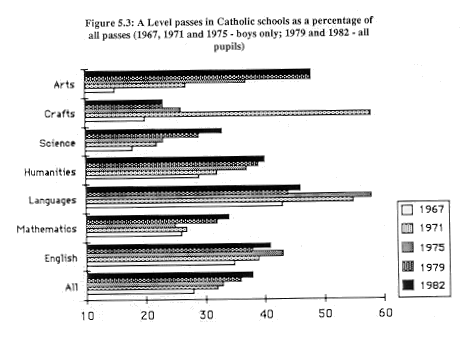  Centre for the Study of Conflict
Centre for the Study of ConflictSchool of History, Philosophy and Politics, Faculty of Humanities, University of Ulster
Centre Publications
[Background] [Staff] [Projects] [CENTRE PUBLICATIONS] [Other Information] [Contact Details] [Chronological Listing] [Alphabetical Listing] [Subject Listing]
Education and Religion in Northern Ireland by A M Gallagher Section 5: The Curriculum of Post-Primary Schools
There exists quite a substantial body of research evidence on
the curricular similarities and differences between Protestant
and Catholic post-primary schools. The work of Greer, on religious
education and Magee, on history, have already been mentioned as
has the 'Schools Apart?' study (Darby et al., 1977). In addition,
there is limited evidence on the time-table allocations of a sample
of pupils in Protestant and Catholic grammar and secondary schools
(Sutherland and Gallagher, 1987). However, the main evidence in
this area concentrates on the public examinations taken by pupils
at 16 and 18. The sources of this evidence are a series of studies
sponsored by the Fair Employment Agency, the NICER Transfer Procedure
project and McEwan et al.'s work on sex differences in A Level
subject choice. Having pointed to the body of research evidence
on the curriculum of Protestant and Catholic post-primary schools
it should be noted that there are no studies comparable to Murray's
(1985) detailed investigation of two primary schools, one Catholic
and one Protestant. Greer (1972) reported the results of a survey on religious education among sixth-form pupils and their Parents in 35 grammar and 7 secondary schools in Northern Ireland. A questionnaire was sent also to the head of the religious education department in each school. Only Protestant schools were used in the survey and, in fact, of the 1,600 or so pupils replying to the survey only 8 were Catholic. Although this survey lacked a comparative dimension (with pupils in Catholic schools in Northern Ireland) there were a number of findings that are relevant to the present study. Firstly, although the pupils in Northern Ireland indicated a higher degree of religious belief and practice than was found in a comparable survey in England, they were also more critical of the way in which religious education was taught in school. Greer found that in all the secondary schools a large number of teachers of religious education were non-specialists with no academic qualification for teaching the subjects. This was somewhat less of a problem in the grammar schools where there was greater use of part-time teachers of religious education such as ministers of religion. In addition, Greer found that religious education was only rarely examined in the schools, either internally or for GCE. This led Greer to suggest that in these schools religious education lacked the status of other subjects and had often become "the 'Cinderella' of the curriculum, the last subject to be considered seriously when man-power, finance and timetables (were) being considered". Greer went on to suggest that "this uncertain position must contribute to the tensions and negative attitudes which were reflected in the comments made by both teachers and pupils" (Greer, 1972 p65). This will be considered again below.
As a final observation from this study, Greer asked the religious
education department heads to indicate the nature of the syllabus
offered to sixth-form pupils. He found that "the study of
other religions, eg Hinduism Buddhism, Humanism, and the study
of social problems were often mentioned as part of the course,
but no mention was made of the problems of comparative religion
which lies at the root of so many social problems in Northern
Ireland, the Protestant-Roman Catholic division. It may well be
the case that problems relating to community relations and religious
controversy formed some part of the discussions in many religious
education and current affairs classes, but in the questionnaire
there was no evidence of any serious attempt to study these problems
with sixth-form pupils" (Greer, 1972 p83). Magee's work on the teaching of history in schools throughout Ireland has already been mentioned in regard to the primary schools. His general critique was that pupils in Protestant post-primary schools were taught Irish history only insofar as it impinged on British history: "The impression generally was that Ulster children could be educated as if they were living in Chelmsford or Bristol or Haverford West" (Magee, 1970 p.19). By contrast, pupils in Catholic post-primary schools were taught Irish history using books published in Southern Ireland and "the emphasis was almost entirely on Irish military heroes" (Magee, 1970 p.19). In a similar vein Barrit and Carter (1962) suggested that Catholic schools treated Irish history as "the story of heroism in maintaining national feeling under foreign rule". Throughout the 1970's this situation improved in that better text-books became available, a wider range of supplementary material was produced (for example, the series of historical documents produced by the Public Records Office of Northern Ireland; see also, Darby, 1974) and innovative suggestions had come forward on local and environmental history teaching (for example Austin, 1985).
Given the importance attached to historical symbols in Northern
Ireland generally, it is not surprising that the teaching of history
quickly came under critical scrutiny. It is equally unsurprising
that this area of the curriculum has undergone marked change in
the last twenty years.
'Schools Apart?' Survey
The 'Schools Apart?' survey of curricula in Protestant and Catholic
post-primary schools revealed some differences and many similarities.
There was a similar level of use of published project materials,
of visits to cultural centres within Northern Ireland, of visits
outside Northern Ireland, of joint activities with other schools
and of shared facilities with other, schools. The range of sports
activities within the post-primary schools was similar in pattern
to that of the primary schools. That is, sports such as Gaelic
footing hurling and camogie were exclusive to Catholic schools
while rugby, cricket and hockey were almost exclusive to Protestant
schools. At the same time all schools engaged in soccer, tennis,
netba1l, basketball and a variety of other sports activities.
AS Part of the NICER Transfer Procedure project, Sutherland and Gallagher (1987) collected the timetables followed by 484 pupils who had obtained an M grade on the 11+ Transfer tests. These pupils were distributed in the first, third and fifth forms of 16 grammar and 14 secondary schools. Half of the schools were Protestant and half were Catholic. The timetabled subjects were grouped into ten different curriculum areas and analysis was based on the percentage time allocated to each of these areas. In each of the three forms Sutherland and Gallagher found that the sample pupils in Catholic schools spent significantly more time on religious education and had more free time on the timetable available for study. By contrast, sample pupils in Protestant schools spent significantly more time on physical education. Among first form pupils, those in Catholic schools spent more time on languages while those in Protestant schools spent more time on science, technological, other vocational and aesthetic subjects. For third formers, those in Catholic schools spent more time on ethical and human/ environmental subjects while those in Protestant schools spent more time on science and aesthetic subjects. In the area of languages Sutherland and Gallagher found that the provision of Irish in most Catholic schools accounted for the greater amount of time devoted to this curriculum area. Typically, in the first and third forms pupils in Catholic schools were studying as many languages as their counterparts in the Protestant schools and, in addition, were studying Irish. By fifth form the main difference in the time devoted to languages was that between pupils in grammar and secondary schools. At the same time, among the Catholic schools just under a third of the grammar pupils and a fifth of the secondary pupils continued to study Irish. It is noteworthy, if perhaps not surprising, that Sutherland and Gallagher found Irish to be unavailable in any of the Protestant schools in the study. In the science area most first formers studied general science as did most third form secondary pupils. By contrast most third form grammar pupils had physics, chemistry and biology timetabled separately. Among the fifth formers physics had become a predominantly male subject while biology had become a predominantly female subject. For the grammar pupils, those in Protestant schools spent more time on each of the three science subjects, although these differences were not statistically significant. For the secondary pupils, those in Protestant schools spent significantly more time on physics, while those in Catholic schools spent significantly more time on both chemistry and biology.
Despite the differences due to the religious affiliation of the
schools in this study, the overall picture provided by these timetable
data was of broad similarity. Indeed, sector differences, between
grammar and secondary schools, and sex differences were perhaps
more striking. The differences that were related to religion included
science and language subjects, although such differences were
more marked in the lower forms. The most consistent differences,
however, were the greater amounts of time, in Protestant schools,
devoted tophysical education, and, in Catholic schools, to religious
education. The latter can be related ot the 'cinderella' status
of religious education in Protestant schools, as described by
Greer, and to the greater denominational homogeneity of Catholic
schools.
Osborne and Murray (1978) and Osborne (1985) have provided a picture
of o Level subject passes for all pupils in Northern Ireland for
the years 1967, 1971, 1975, 1979 and 1982 (see also Osborne and
Cormack, 1989). These studies were published by the Fair Employment
Agency and as such are primarily concerned with the qualifications
taken into the labour market by pupils from Catholic and Protestant
schools. Because these data relate to O Level passes, rather than
subjects taken, and because they relate to external examinations
rather than timetable allocations, they do not provide a direct
picture of the curriculum followed by pupils in these schools.
However, the studies are based on the entire school populations for those years and thus provide an important comparative Picture of both school systems.
Figure 5.1 presents the percentages of boys who obtained O Level
passes in Catholic schools in various subject groupings in 1967,
1971 and 1975. The vertical line with the percentage figure at
its base for each of the years represents the proportion of boys
obtaining O Level passes in Catholic schools for each of the years.
This percentage figure represents the comparative baseline for
each of the years.  Between 1967 and 1975 a number of points can be noted from these figures. Firstly, the proportion of 0 Level passes for boys in Catholic schools remained higher in languages than their overall rate of passing. From a disproportionately low rate of passes in 1967 in art/music/religious education, boys in Catholic schools achieved a disproportionately high rate of passes in these subjects in 1975. This may be primarily related to their results in religious education (see below). The rate of passes among these pupils fluctuated for crafts subjects. By contrast, the reverse was true for science subjects where boys in Protestant schools achieved a disproportionately high rate of passes in each of the years. It should be noted also that the proportion of passes achieved by boys in Catholic schools overall increased over these years.
Figure 5.2 presents the proportion of O Level passes obtained
by all pupils in Catholic schools in subject groupings for 1979
and 1982 and once again incorporates a baseline figure for all
passes. Many of the trends identified for boys in the earlier
years continue when all pupils are considered. Thus, pupils in
Catholic schools obtain a disproportionately high rate of O Level
passes in languages and RE/arts subjects. This is true also for
commerce/accounts and craft subjects, although these are minority
subject choices. At the same time, pupils in Catholic schools
obtain a disproportionately low rate of O Level passes in physics/chemistry
and technical drawing.
 O Levels among grammar school pupils One of the studies in the NICER Transfer Procedure project (Gallagher, 1988) collected details on the public examinations taken by a sample of some 1,500 pupils who transferred from primary to post-primary education in 1981. Thus, most of these pupils would have sat O Level, CSE and other public ,examinations in 1986. English language, English literature and mathematics were the three most frequently taken O Level subjects by the sample pupils in Protestant and Catholic grammar schools. Indeed, in the ten most frequently taken O Levels for each of these two groups, the subjects appearing on only one list were additional maths (tenth most frequently taken among Protestant grammar pupils) and religious education (fourth most frequently taken among Catholic grammar pupils). Overall, the pattern of O Level subject choice was broadly similar. Of the twenty O Level subjects taken by the grammar pupils, only seven had a differential rate of taking of 10% or more in either sector. Table 5.1A lists these subjects and the proportions - taking them in the Protestant and Catholic grammar schools.
Table 5.1A: O Level subject choices - main differences between
Protestant and Catholic grammar samples.
Perhaps the most significant element of this table is the differential
rate at which O Level religious education is taken in Protestant
and Catholic grammar schools. This difference appears to further
confirm the suggestions of Greer discussed above (i.e. that in
Protestant schools religious education is treated as "the
'Cinderella' of the curriculum') and to highlight the further
development of the trend identified in the data of Osborne and
Murray (1978) and Osborne (1985).
Similar data from Gallagher (1988) for secondary pupils revealed
a high degree of similarity in the subjects taken. The main areas
of difference were that pupils in Protestant secondary schools
were more likely to take CSE "writing (22% vs. 9%), 16+ (a
precursor of GCSE) mathematics (19% vs. 5%), CSE general english
(45% vs. 32%) and CSE english literature (32% vs. 16%). Although
no pupils in Protestant secondary schools took irish, this was
true also for less than 3% of the pupils in Catholic secondary
schools. The only other subject difference was for religious education.
While about a quarter of both groups took CSE religious education,
almost a fifth of the pupils in Catholic secondary schools took
O Level religious education compared with a fiftieth of those
in Protestant secondary schools.
Figure 5.3 presents the rate of A Level passes in subject areas
for pupils in Catholic schools. This figure is based on data in
Osborne and Murray (1978) and Osborne (1985) and is for boys only
for 1967, 1971 and 1975, and for all pupils in 1979 and 1982.
For pupils in Catholic schools the figure suggests a disproportionately
higher rate of passes in english and languages. By contrast there
is a disproportionately lower rate of passes in science subjects.
There has been a lower, but inconsistent, rate of passes in craft
subjects for pupils in Catholic schools, while the rate has steadily
increased from lower than their overall rate of passing in 1967
to higher in 1982 for arts subjects (this includes religious education).
Differences in science A Level subjects due to the religious school
systems were confused by a survey of some 1,400 sixth-form pupils
in 21 grammar schools in Northern Ireland (McEwan et al., 1986;
n.d.). Although the survey found no differences for girls in Protestant
or Catholic grammar schools, significant differences were found
for boys. Thus, while 28% of the boys in Protestant grammar schools
were not taking any science A Level subject, this was true for
41% of the boys in Catholic grammar schools. Similarly, the average
number of science A Level among boys in Protestant grammar schools
was 1.8, compared with an average of 1.3 for boys in Catholic
grammar schools.
 Further research areas As this section indicates, there exists a great deal of information on the subjects studied at Protestant and Catholic post-primary schools and the differences between the school systems. There may be a case for more in-depth studies of the curriculum in the classroom. Such an investigation might provide information on the time devoted to non-examination subjects on the curriculum of schools. The proposed national curriculum will have its greatest impact on the post-primary sector and may have the effect of narrowing differences between the religious school systems. Having said that, it appears there will be a degree of flexibility for schools in their organisation of the curriculum: monitoring the use that is made of the available flexibility in the national curriculum will be an important research area.
Perhaps a more fundamental issue concerns the extent to which
schools can provide the proposed national curriculum: for example,
are there enough science and technology teachers currently in
place in all schools? Even if this is the case, are the specialist
teaching facilities currently available? While some research
will focus on the impact of the educational reform proposals on
schools, these questions address the very feasibility of some
of these reforms. Return to publication contents
Pat Shortt, Room L014, University of Ulster, COLERAINE, Northern Ireland, BT52 1SA T: (01265) 324666, F: (01265) 324917, E: mp.shortt@ulst.ac.uk © Centre for the Study of Conflict and the Author(s) Last Modified by Martin Melaugh : | ||||||||||||||||||||||||||||||||||||||||||